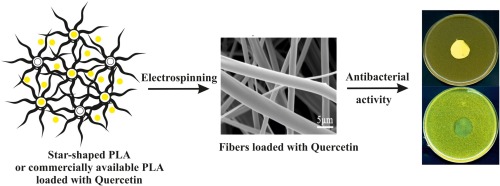Copyright © 2022 Foshan MBRT Nanofiberlabs Technology Co., Ltd All rights reserved.Site Map
1. Why is electrospun PLA an ideal way to prepare wound dressings?
In the process of wound healing, wound dressing can replace damaged skin to act as a temporary barrier. The ideal wound dressing has the functions of accelerating wound healing, preventing infection, and restoring skin structure and function in a short time. Polylactic acid (PLA for short), or polylactide, is a synthetic polymer material with good biodegradability, biocompatibility and bioabsorbability. Electrospinning is a convenient and efficient method for preparing PLA nanofibers with relatively low equipment costs. It is also the most common and practical method for producing PLA nanofibers.

Figure 1 Electrospun PLA/HPG composite nanofiber wound dressing
2. Why PLA nanofibers have received a lot of attention from scholars in the field of medical wound dressings?
With the advancement of science and technology, PLA nanofiber new medical wound dressings prepared by electrospinning technology have gradually entered people's field of vision. PLA nanofibers have the characteristics of high specific surface area, high porosity, controllable pore size and good ductility. They can be made into dressings of various sizes and shapes that are easier to fit complex wound contours to achieve better treatment effects. Antibacterial ingredients are added in the PLA electrospinning process to prepare antibacterial PLA nanofiber dressings, which can effectively inhibit wound infection. In addition, PLA nanofiber wound dressings with biologically active substances can be prepared according to the needs of medical treatment, which can better promote the adhesion and proliferation of cells at the wound and accelerate wound recovery. For the above reasons, PLA nanofibers have been studied by a large number of scholars in the field of medical wound dressings.


Figure 2 Breathable wound dressing
PLA nanofibers have high porosity and good air permeability, which can efficiently absorb wound exudate and keep the wound in an ideal moist state. At the same time, it is conducive to the full contact of the wound with external oxygen, and promotes the timely gas exchange of cells, thereby accelerating wound healing. Since the composition of electrospun nanofibers is controllable, loading antibacterial agents or biologically active substances in PLA electrospun nanofibers can obtain a new functional wound dressing.

Figure 3 Electrospun PLA/quercetin composite antibacterial dressing
3. What are the advantages of PLA nanofibers in the biological field?
In view of the lack of antibacterial properties of traditional dressings, it is easy to cause wound infection, poor cell respiration at the wound, and slow wound healing rate during use. PLA nanofiber new functional wound dressings have been studied by a wide range of scholars. PLA nanofibers have a large specific surface area, a controllable porosity and good biological properties, which are not only beneficial to cell respiration, but also can inhibit bacterial infection of wounds, and can promote cell proliferation and accelerate wound healing. In addition, PLA has good biodegradability, can better meet the current new requirements for the development of environmentally friendly materials, and is a new development direction in the field of wound dressing research and development in the future.